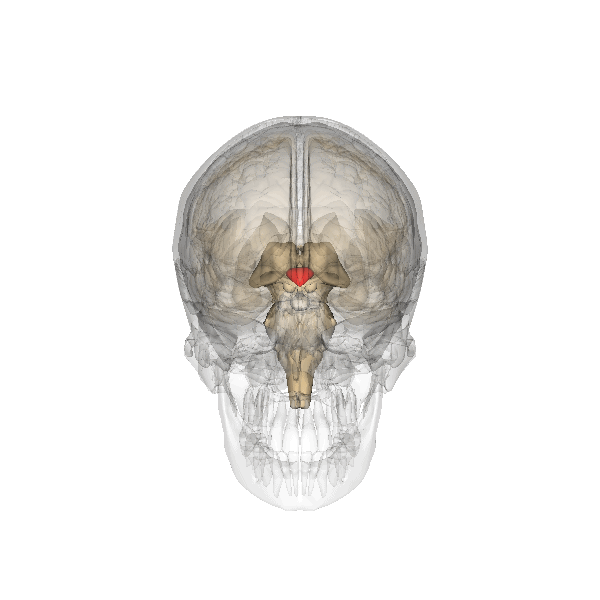Special neurons in the brain respond to increases in temperature around and at the same time tell your body how to escape the heat.
When we become hot, we sweat, breathing quickens, we try to leave in the shade, drink cold water, to remove – if possible – the extra clothes. When we are cold, we shiver, try to dress warmly, etc. That is the temperature changes cause a complex variety of reactions, physiological and behavioral, which obviously should start with some internal “thermometer”. Of course, we animals have thermoreceptors, but their only job is to collect information and transmit it to the brain in some special Department, the neurons of which figure out how high or how low the temperature is now and what should be done.

The hypothalamus in the human brain. (Photo djr339 / www.flickr.com/photos/68606544@N02/6240818909.)
“”
It is known that neural “thermometer” is located in the hypothalamus – a small region in the intermediate brain that regulates neuroendocrine activity and homeostasis of the body. The hypothalamus itself is divided into a number of structures and areas, among which are the so-called preoptičeskoj area. Experiments with animals have shown that thermoregulation does just preoptičeskoj area. But the hypothalamus is very small, and that is associated with a variety of things: for example, it is involved in the regulation of sleep, regulation of mating and parental behavior, it regulates hunger and thirst, etc. We are also interested in specific neurons that work with temperature, and for a long time nobody has been able to determine.
To find them managed laboratory staff Zachary knight (Zachary Knight) at the University of California in San Francisco. Using a special method, the development of which took five years, they were able to determine which genes and in what cells preoptičeskoj areas of the hypothalamus are activated in response to the warming air. That is required not only to notice those neurons that responded to environmental changes neurochemical impulses, but to understand whether this is accompanied by the activity of some molecular-genetic events.
In neurons, which are more suited for the role of “thermometer”, was particularly strong genes PACAP and BDNF. Both of them encode proteins related to growth and development of neurons and regulation of hormonal signals in the brain, but in this case it is important not only to their specific function, but the fact that they are activated in certain cells and in response to certain circumstances. In other words, in the hypothalamus were able to find cells that respond to heat and which in fact was a characteristic molecular feature – the increased activity of these two genes. Moreover, the article in Cell , the authors write that PACAP and BDNF worked for a few seconds after the cage with the mice increased temperature. It used to be that terminaron preoptičeskoj zone of the hypothalamus with the skin’s receptors no cases have not only measuring the internal temperature of the body. However, apparently, the cells of the hypothalamus directly communicate with external thermoreceptors – how else to explain such a rapid response to the hypothalamic “thermometer”? Another proof were obtained in experiments with capsaicin – an alkaloid found in red pepper. Capsaicin acts on a receptor protein associated with a feeling of warmth and heat, and the cells preoptičeskoj zone of the hypothalamus have responded to the “pepper” is exactly the same as the heat – that is, the thermoreceptors on the skin really directly related terminalone of the hypothalamus.
Of course, the researchers wanted to know whether these cells for the physiology and behavior of animals – that is, if the mice would hide in a cold place, if they artificially, without any external heat to stimulate the hypothalamic “thermometer”. And all that is exactly what happened: when the mice directly, directly in the hypothalamus, activated thermoclick, in animals, decreased body temperature, and they tried to find a cage in the corner cooler. Physiological reaction was the same as in normal mice in response to normal increase in air temperature: the blood vessels in the tail expanded, and the amount of metabolic heat in the adipose tissue decreased.
In General, the obtained results suggest that certain neurons preoptičeskoj zone of the hypothalamus, which in response to heat activated genes PACAP and BDNF, not just measure the outside temperature (via skin receptors), but also tell your body how can he behave in a new environment: whether it is necessary to regulate metabolism, what to do with the blood vessels, you need to look for a shadow, etc. However, it is important to emphasize that thermoclick responded only to temperature rise – on cold, on low temperature, they did not respond. That is, in this case, the “nanothermometer” only works in one direction, and for the cold, obviously, there are some other brain neural centers, which, presumably, will soon also be able to find.
Author: Cyril Stasevich
Source: nkj.EN







